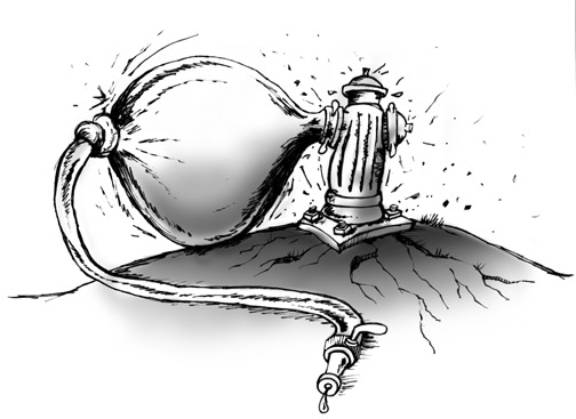What
Happens to a Man’s Body After Vasectomy?
By
Kevin C. Hauber
03/25/01
|
How does
vasectomy affect a man’s body? This
is a reasonable question, which unfortunately is rarely answered, even
after significant effects occur. Let’s
use an analogy of a 40-year-old fire hose.
You hook this fire hose up to a hydrant and turn on the water.
Let the hose represent the epididymis portion of the testicles and
the vas deferens, which would measure some 20 feet in length if stretched
out, and let the water represent the 50,000 sperm cells a minute that a
man’s body manufactures, even after vasectomy. Now,
tie a knot in the fire hose. What
happens? Something is going
to rupture, right? That’s
why fire departments don’t use 40-year-old fire hoses, and why men
develop ruptures in their testicles after their vas is tied off during the
vasectomy procedure.
Ruptures Actually, the
technical term for this phenomena is a “blowout.”
According to Campbell’s Urology (a textbook for urology students
and doctors) “The brunt of pressure-induced damage after vasectomy falls
on the epididymis and efferent ductules…. It is likely that, in time,
all vasectomized men develop ‘blowouts’ in either the epididymis or
efferent ducts.” I wish I
had known this before I had my vasectomy and started experiencing some of
the negative effects of that rupturing process. Autoimmune
Responses But that’s
not all. When the rupturing
occurs, sperm cells enter the blood stream, where they were not naturally
intended to be. As a matter
of fact, nature makes a very specific point of keeping sperm cells out of
the blood stream, because sperm cells have very strong enzymes on their
surfaces and only half a DNA strand.
What does the body think is happening?
The immune system is sent on full alert to fight off a perceived
infection, and the body becomes “autoimmune”, i.e. the body goes to
war on itself. Again from
Campbell’s Urology: “Vasectomy results in violation of the
blood-testis barrier producing detectable levels of serum antisperm
antibodies in 60 to 80 per cent of men….”
Once this reaction starts, it is difficult to stop, even with a
vasectomy reversal. It would
have been good to know this also before it began happening in me. Why is this
autoimmune response important? Well,
numerous reactions have been identified as part of this autoimmune
response. Cysts of various sorts begin to form in the scrotum.
In about three men out of five, a sperm granuloma forms at the
rupture site, and may need to be removed surgically to alleviate painful
symptoms. Other types of
cysts often form in the epididymis and/or the scrotum including
spermatoceles and hydroceles, which may also require further treatment or
lead to other problems. The
autoimmune response that follows vasectomy has also been linked to an
increase in the incidence of numerous diseases by dozens of studies. These diseases include testicular dysfunction and hormonal
imbalances, recurrent infections, various forms of cancer, and other
immune system deficiencies. According
to Dr. H. J. Roberts, an internist who has studied the effects of
vasectomy on the immune system for over 30 years, “ no other operation
performed on humans even approaches the degree and duration of the
multiple immunologic responses that occur in the post-vasectomy state.” Pain
and Injury Problems
during the procedure itself often cause damage to testicular blood and
nerve supplies, and also commonly cause damage to delicate lymph vessels.
Chronic testicular pain is an often undisclosed and potentially
debilitating result of vasectomy. Unfortunately,
I can speak to this issue firsthand also, having endured more than a year
and a half of chronic pain since my original vasectomy.
Urologists tend to play this aspect down, but if you read the
literature, you will find a significant incidence of chronic pain
resulting from the kinds of reactions discussed thus far.
In surveys that asked patients about their post-vasectomy
experience, up to a third of vasectomized men complained of chronic
testicular pain of varying degrees. Some,
like myself, have sought further medical treatment, and even surgery in an
attempt to resolve this painful situation. The
Bottom Line If you feel
that this is a rare occurrence, I invite you to visit the forum and
reference sections of the web site at www.dontfixit.org
and see for yourself. And if
you think that the negative effects of surgical sterilization are
restricted to men, I invite you to see the web site posted by the
Coalition for Post-Tubal Women at www.tubal.org. Both of these sites will provide a real eye-opening
experience. The bottom line is that it is much better and easier to make minor adaptations in your sexual practices than it is to alter your body surgically. Condoms and other forms of barrier-type contraceptives are something we all need to become more comfortable with and proficient at using, even in long-term, monogamous relationships. Contraception and population control are important issues on many levels. But preserving the health of the living is an issue that needs to take precedence in this situation. Telling the truth about the consequences of vasectomy and other forms of surgical sterilization are of critical importance to the individual in the decision making process about contraceptive choices. |
